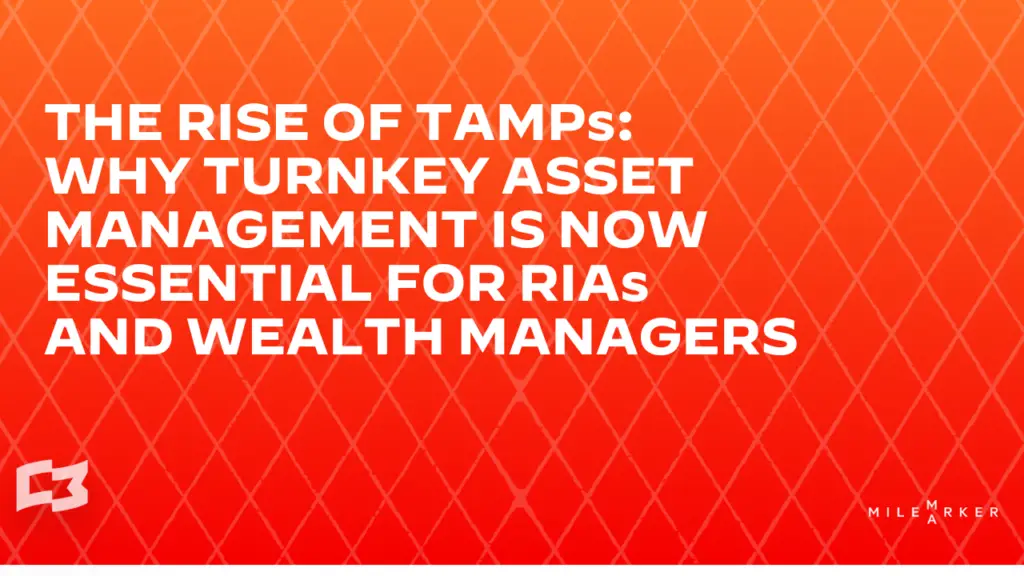The Rise of TAMPs: Why Turnkey Asset Management is Now Essential for RIAs and Wealth Managers

In recent years, Turnkey Asset Management Platforms (TAMPs) have transitioned from niche offerings to integral components of the wealth management industry. This evolution reflects a broader shift in how Registered Investment Advisors (RIAs), broker-dealers, banks, and family offices approach portfolio management and client service. The growth of TAMPs signifies not just a change in tools but a fundamental transformation in business strategy, operational efficiency, and client engagement.
The Evolution of TAMPs
Originally, TAMPs emerged as outsourced solutions for advisors seeking to streamline portfolio management and administrative tasks. They provided a suite of services—including investment management, performance reporting, and back-office operations—allowing advisors to focus more on client relationships and less on operational burdens.
According to a report by Cerulli Associates, the assets under management (AUM) in TAMPs have seen significant growth, reaching over $2 trillion in recent years (Cerulli Associates). This surge is attributed to the increasing complexity of investment products, regulatory pressures, and the need for scalable technology solutions.
TAMP Growth and Market Dynamics
The expansion of TAMPs aligns with the broader industry trend toward outsourcing and specialization. Boston Consulting Group highlights that wealth managers are facing margin pressures and increasing client expectations, driving them to seek more efficient operating models (Boston Consulting Group). TAMPs offer a scalable solution that addresses these challenges.
InvestmentNews notes that the adoption of TAMPs among RIAs has accelerated, with a reported 60% of advisors using or considering TAMP services (Stevens). This growth is fueled by the platforms’ ability to provide sophisticated investment strategies without the need for in-house portfolio management teams.
Benefits of TAMPs for Wealth Managers
1. Operational Efficiency
By outsourcing asset management and administrative tasks, advisors can reduce overhead costs and streamline operations. WealthManagement.com emphasizes that TAMPs enable advisors to delegate time-consuming functions, allowing them to allocate more time to client acquisition and retention (Johnson).
2. Access to Advanced Investment Strategies
TAMPs offer access to a broad range of investment products and strategies that may not be readily available to individual advisors. This includes alternative investments, tax-optimized portfolios, and ESG options, providing a competitive edge in portfolio customization.
3. Regulatory Compliance and Risk Management
With increasing regulatory scrutiny, TAMPs help advisors navigate compliance challenges by providing robust reporting and adherence to fiduciary standards. Harvard Business Review discusses how outsourcing complex functions can mitigate operational risks and ensure compliance (Smith and Johnson).
4. Scalability and Growth
TAMPs support business growth by providing scalable solutions that can accommodate an expanding client base without proportional increases in costs. This scalability is crucial for RIAs and family offices aiming to grow AUM while maintaining service quality.
Essential TAMPs for Wealth Managers
The integration of TAMPs into wealth management practices is no longer optional but essential. SEI, a leading provider of TAMP services, underscores that the platforms enable advisors to adapt quickly to market changes and client needs (SEI Investments). The essential nature of TAMPs is further reinforced by their ability to deliver personalized client experiences through advanced technology and data analytics.
Bain & Companyhighlights that client expectations are shifting toward more personalized and tech-enabled services, and TAMPs are at the forefront of delivering these experiences (Bain & Company).
Case Studies and Industry Examples
• Bank Adoption: Banks have leveraged TAMPs to enhance their wealth management divisions without significant investments in technology infrastructure. This approach allows banks to offer competitive services aligned with market leaders.
• Family Offices: By utilizing TAMPs, family offices can access specialized investment strategies and reporting capabilities, essential for managing complex family wealth structures.
Future Outlook
The trajectory of TAMP growth suggests continued integration into wealth management practices. Barron’s predicts that technological advancements and increased competition among TAMP providers will drive innovation, benefiting advisors and clients alike (Davis).
Moreover, the COVID-19 pandemic has accelerated digital adoption, making technology-driven solutions like TAMPs even more critical. Advisors are expected to continue embracing these platforms to meet evolving client demands and stay competitive in a rapidly changing industry landscape.
Conclusion
The rise of TAMPs reflects a significant shift in wealth management, where efficiency, scalability, and advanced capabilities are paramount. For RIAs, broker-dealers, banks, and family offices, adopting TAMPs is essential not just for operational improvement but for delivering enhanced value to clients.
As the industry continues to evolve, TAMPs will likely become even more integrated into the fabric of wealth management, driving innovation and setting new standards for client service.
Works Cited
• Bain & Company. The Changing Face of Wealth Management in the Digital Age. Bain & Company, 2020.
• Boston Consulting Group. Global Wealth 2021: When Clients Take the Lead. BCG, 2021.
• Cerulli Associates. U.S. Managed Accounts 2020: The Future of Personalized Portfolios. Cerulli Associates, 2020.
• Davis, John. “Why TAMPs Are Becoming Indispensable for Advisors.” Barron’s, 15 June 2021.
• Johnson, Emily. “TAMPs Drive Efficiency for Growing RIAs.” WealthManagement.com, 22 March 2021.
• SEI Investments. The Value of Outsourcing: How TAMPs Enhance Advisor Growth. SEI, 2021.
• Smith, Laura, and Michael Johnson. “Outsourcing and Risk Management in Financial Services.” Harvard Business Review, vol. 98, no. 4, 2020, pp. 45-53.
• Stevens, Mark. “The TAMP Takeover: Why RIAs Are Turning to Outsourced Solutions.” InvestmentNews, 10 Sept. 2021.